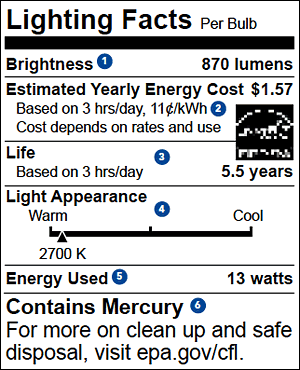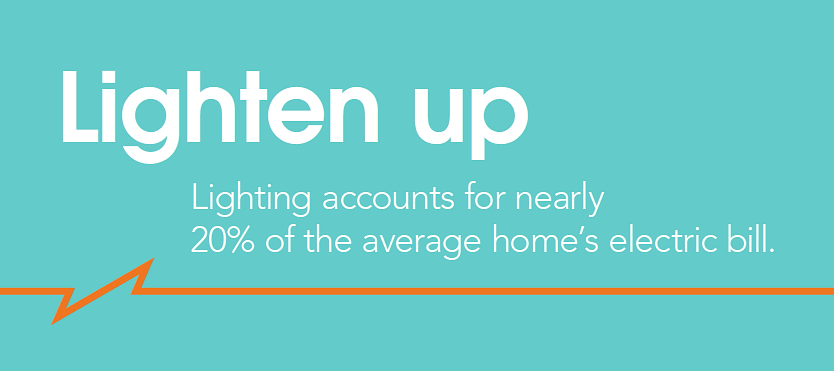
Hello, Lumens!
Goodbye, Watts.
For years, we have selected bulbs by their wattage. Watts measure the amount of energy a bulb uses. Because newer bulbs are so much more energy-efficient it is easier to choose a bulb based on its brightness.
Lumens measure the brightness of a bulb. More lumens mean brighter light.
To make buying bulbs easier, new packaging includes the Lighting Facts label, indicating brightness, estimated operating cost and life, and the color of the light (from warm/yellow, to white, to cool/blue).

A Lighting Facts Label is found on most light bulb packaging. Use this information to choose the right bulb for your specific needs.
- Brightness is expressed in lumens. ENERGY STAR® certified LEDs and CFLs provide more brightness using less energy.
- The average customer will pay this amount to operate this bulb each year.
- The life is an estimate of how long the bulb will operate. Energy-efficient bulbs last 10 to 25 times longer than incandescent bulbs.
- Color temperature ranges from warm white light to cool natural light and is measured in Kelvin (K).
- The amount of energy needed to power the bulb
is measured in watts. The fewer watts, the less
energy used.
- CFL bulbs contain a small amount of mercury. Be
sure to handle and dispose of them properly. LED
bulbs contain no mercury!
Timing is everything.
Of course you can flick a switch and turn lights off when you aren't using them but sometimes we forget. Timers are a great way of controlling exterior lights, lights in low-traffic areas and even bathroom exhaust fans.
Dimmers are another inexpensive way to adjust interior lighting and save energy. Motion sensors are especially useful for outdoor security and lighting. Similarly, occupancy sensors turn lights on and off automatically when someone enters or exits a room.

Help! What is the right bulb for me?
You might have noticed some big changes in the lighting aisle recently. In addition to traditional incandescent bulbs, you will find: Light-Emitting Diodes (LEDs), Compact Fluorescent Lights (CFLs) and halogen light bulbs.
Compared to traditional incandescent bulbs, ENERGY STAR® - certified LEDs and CFLs use 75-80% less energy, last at least 6 years longer, and produce less heat, making them safer to operate while cutting energy costs associated with home cooling.
Benefits of LEDs
- Excellent quality - color and brightness appear more like that of traditional incandescent bulbs.
- Long lifetime.
- Light up immediately, even in cold weather.
- Do not contain mercury.
- Made of durable plastic.
- Remain cool to the touch.
- Compatible with dimmers and occupancy sensors.






